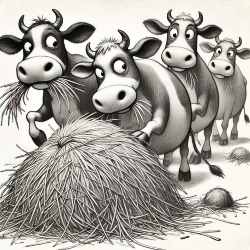Cow Hay Supply

The Cow Hay Supply Calculator helps cattle owners calculate the hay required for their herd during specific periods, such as winter when pasture is unavailable. This tool ensures you can accurately plan your hay supply based on the number of cows and feeding duration.
Cow Hay Supply Calculator
Calculator
- enter the average weight of the cows in your herd in pounds
- the total number of cows in your herd
- specify the number of days for which you need to provide hay (e.g., 121 days over winter)
- the average weight of the hay bales you are using, in pounds
- the average moisture content of the hay bales (e.g., 14%)
- estimate the percentage of hay waste due to storage conditions (e.g., outdoor storage)
- estimate the percentage of hay waste due to feeding practices
Results
- the amount of dry matter hay daily based on its weight per cow
- the total amount of hay needed (in dry matter) for the herd over the specified number of feeding days
- the total number of hay bales required, adjusted for the moisture content of the bales, storage, and feeding waste
This tool is crucial for planning hay supplies for cattle when pasture is unavailable, ensuring that your herd's nutritional needs are met.
Cows' hay requirements are based on their body weight, nutritional needs, and the quality of the hay (specifically the dry matter content). Here's a detailed look at how these factors affect their hay intake:
Dry Matter Intake (DMI)
Cows eat forage (hay) based on its dry matter content (the nutrients and fibre in the hay, excluding water). Cows generally consume around 2-3% of their body weight in dry matter each day.For example:
- A cow weighing 1,200 lbs typically consumes around 24-36 pounds of dry matter hay daily.
Nutritional Needs Based on Type
Beef Cows: Beef cows typically need about 2% of their body weight in dry matter per day, though this can increase if the cow is lactating or during colder weather.Dairy Cows: Due to their higher energy demands, dairy cows may require more feed, especially during lactation. They might consume up to 3% of their body weight in dry matter.
Hay Quality
Dry Matter (DM) Content: High-quality hay has higher dry matter content (less water), meaning cows get more nutrients per pound. Lower-quality, wetter hay will require a cow to eat more to meet its dry matter needs.Protein and Fiber Content: Nutritionally rich hay with higher protein and fibre is preferred, as it meets cows' energy needs and promotes healthy digestion.
Moisture Content (MC)
Impact on Consumption: Hay with higher moisture content provides less dry matter per pound, meaning cows need to eat more to meet their nutritional needs.- For example, if hay has a moisture content of 20%, only 80% of its weight is dry matter. If a cow needs 25 pounds of dry matter, it must consume more than 25 pounds of this hay.
Environmental Factors
Weather: During cold weather, cows require more hay to maintain body temperature and energy levels, which could increase their hay consumption by up to 25%.Stage of Life: Pregnant and lactating cows have higher nutritional needs and will consume more hay to meet energy and protein demands.
Hay Loss
Storage Waste: Hay stored outside can lose up to 20-30% of its dry matter value due to exposure to the elements.Feeding Waste: When hay is fed on the ground or in open spaces, cows can waste around 5-20% due to trampling and soiling.
General Calculation for Hay Needs:
If you have a 1,200 lb cow:Daily Hay Requirement (dry matter): 24-36 lbs daily, depending on activity and other factors.
Monthly Hay Requirement: 720-1,080 lbs of dry matter hay.
Total hay Needed (over 100 days): 2,400-3,600 lbs of dry matter.
This helps farmers estimate the hay their cows need, especially when pasture is unavailable.
Farming Calculators
Main PageHay and Silage
- Cow Hay Supply - Estimates total hay needed to feed cows based on weight and consumption rate.
- Hay Bale Count for Barn Storage - Calculates the number of hay bales stored in a given barn space.
- Hay Bale Count for Barn Storage (Metric) - Computes hay bale storage capacity using metric units.
- Hay Bale Estimation - Estimates the number of hay bales needed based on field size and bale size.
- Hay Bale Estimation - Metric - Computes hay bale requirements using metric measurements.
- Hay Bale Value and Dry Content - Determines the value of hay bales based on dry matter content and moisture percentage.
- Hay Bale Value and Dry Content (Metric) - Computes hay bale value and dry matter content using metric units.
- Horse Hay Supply - Estimates the hay needed for horses based on body weight and feeding period.
- Silage Weight Calculator - Computes total silage weight based on moisture content and dry matter density.
- Silage Weight Calculator (Metric) - Calculates total silage weight using volume and moisture content metric units.